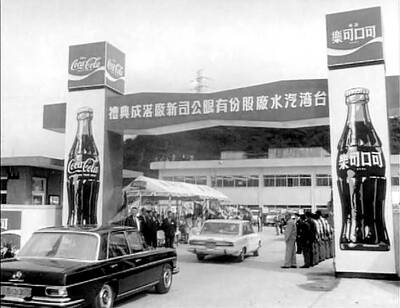The Novel Hall Dance series is celebrating its 10th anniversary this year with an eclectic program that spans the world music and dance genres.
It was always going to be hard to top last year’s program — the astounding visit by the Paul Taylor Dance Company in October — but for sheer diversity, this series’ line-up may excel. There is a pair of New York-based Japanese modern dancers working with a troupe of young Cambodian artists, an award-winning British choreographer’s fast-moving dance troupe and a very young (13) flamenco prodigy.
“Mr Lin [Hwai-min (林懷民), founder and artistic director of Cloud Gate Dance Theatre and Novel Hall Dance] said the focus this year was on ‘young, new and tomorrow,’” said Elaine Huang (黃麗宇), public relations manager of Novel Hall in a telephone interview. “So the Cambodian students with Eiko and Koma represent the young, Wayne McGregor represents the new and El Yiyo will certainly have many tomorrows.”
Huang also said it was appropriate to open this year’s series with the renowned performance duo Eiko Otake and Takashi Koma Otake, since they had been in the series’ inaugural program.
Eiko and Koma have been breaking barriers since they met as university students in Tokyo when they joined the Tatsumi Hijikata company in 1971 and left their law and political science studies behind.
They quickly formed an exclusive partnership and began performing in Tokyo before moving to Germany to study modern dance with Manja Chmiel. They used Amsterdam as a base to tour Europe for a few years before settling down in New York. Over their careers they have incorporated video, musicians, paintings and landscape into their works, and developed a reputation for outdoor performances, all in an effort to break through the confines of traditional theater and reach a wider audience.
They have collected numerous fellowships, performance awards and other honors and in 1996 they became the first partnership to be awarded one of the MacArthur Foundation “genius” fellowships.
In 2004, Eiko and Koma began what has become a very fruitful collaboration with students and graduates of the Reyum Institute of Arts and Culture in Phnom Penh, Cambodia, a nongovernmental organization. They had been invited to the school after one of its founders saw them perform in New York.
A month-long workshop at the school led to the creation of Cambodian Stories: An Offering of Painting and Dance, which premiered in 2006, and Cambodian Stories Revisited in 2007.
In Cambodian Stories, the pair perform with young Cambodian painters and dancers to a score by Cambodian-American musician Sam-Ang Sam that mixes Cambodian popular songs and instrumental music.
The piece opens with a bare stage covered in sand, decorated with panels of traditional Cambodian dancers and strung with blank canvases. The young dancer/artists create their own landscape as they tell a story about their lives, love and painting.
From Cambodia, the Novel Hall Dance series moves to contemporary British dance, with McGregor’s Random Dance troupe performing Entity from May 22 to May 24, and finishes up with El Yiyo in New Flamenco Generation from June 5 to June 7.

July 28 to Aug. 3 Former president Chiang Kai-shek (蔣介石) reportedly maintained a simple diet and preferred to drink warm water — but one indulgence he enjoyed was a banned drink: Coca-Cola. Although a Coca-Cola plant was built in Taiwan in 1957, It was only allowed to sell to the US military and other American agencies. However, Chiang’s aides recall procuring the soft drink at US military exchange stores, and there’s also records of the Presidential Office ordering in bulk from Hong Kong. By the 1960s, it wasn’t difficult for those with means or connections to obtain Coca-Cola from the

No one saw it coming. Everyone — including the Chinese Nationalist Party (KMT) — expected at least some of the recall campaigns against 24 of its lawmakers and Hsinchu Mayor Ann Kao (高虹安) to succeed. Underground gamblers reportedly expected between five and eight lawmakers to lose their jobs. All of this analysis made sense, but contained a fatal flaw. The record of the recall campaigns, the collapse of the KMT-led recalls, and polling data all pointed to enthusiastic high turnout in support of the recall campaigns, and that those against the recalls were unenthusiastic and far less likely to vote. That

A couple of weeks ago the parties aligned with the People’s Republic of China (PRC), the Chinese Nationalist Party (KMT) and the Taiwan People’s Party (TPP), voted in the legislature to eliminate the subsidy that enables Taiwan Power Co (Taipower) to keep up with its burgeoning debt, and instead pay for universal cash handouts worth NT$10,000. The subsidy would have been NT$100 billion, while the cash handout had a budget of NT$235 billion. The bill mandates that the cash payments must be completed by Oct. 31 of this year. The changes were part of the overall NT$545 billion budget approved

Trolleys piled high with decapitated silicon monster heads, tattooed dealers lurking in alleyways, bin bags of contraband hidden behind shop counters: welcome to the world of Lafufus. Fake Labubus (拉布布), also known as Lafufus, are flooding the hidden market. As demand for the collectable furry keyrings soars, entrepreneurs in the southern trading hub of Shenzhen are wasting no time sourcing imitation versions to sell to eager Labubu hunters. But the Chinese authorities, keen to protect a rare soft-power success story, are cracking down on the counterfeits. “Labubus have become very sensitive,” says one unofficial vendor, in her small, unmarked, fake designer goods